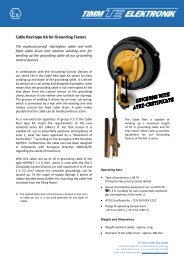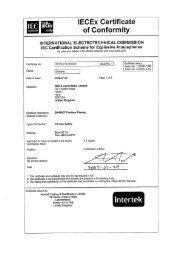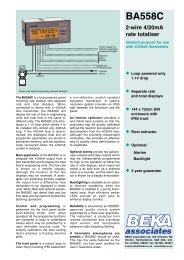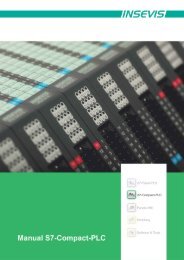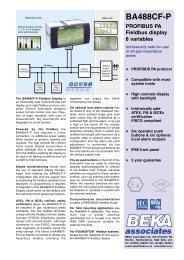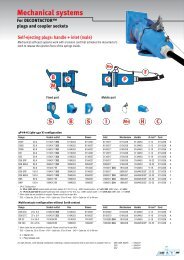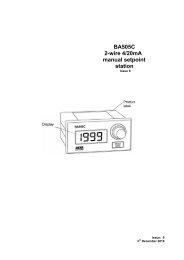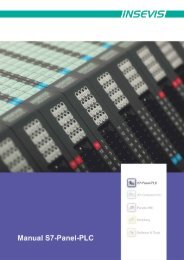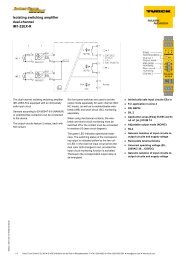1 Inductive slot sensor SJ15-N-5M - Ex-Baltic
1 Inductive slot sensor SJ15-N-5M - Ex-Baltic
1 Inductive slot sensor SJ15-N-5M - Ex-Baltic
- No tags were found...
You also want an ePaper? Increase the reach of your titles
YUMPU automatically turns print PDFs into web optimized ePapers that Google loves.
<strong>Inductive</strong> <strong>slot</strong> <strong>sensor</strong><br />
<strong>SJ15</strong>-N-<strong>5M</strong><br />
ATEX 1D<br />
Instruction<br />
Manual electrical apparatus for hazardous areas<br />
Device category 1D<br />
for use in hazardous areas with combustible dust<br />
Directive conformity<br />
94/9/EG<br />
Standard conformity<br />
IEC 61241-11:2002: draft; prEN61241-0:2002<br />
type of protection intrinsic safety "iD"<br />
Use is restricted to the following stated conditions<br />
CE symbol 0102<br />
<strong>Ex</strong>-identification<br />
EC-Type <strong>Ex</strong>amination Certificate<br />
Appropriate type<br />
Effective internal capacitance C i<br />
Effective internal inductance L i<br />
General<br />
Maximum housing surface temperature<br />
Installation, Comissioning<br />
Maintenance<br />
Special conditions<br />
Electrostatic charging<br />
¬ II 1D <strong>Ex</strong> iaD 20 T 108 °C (226.4 °F)<br />
ZELM 03 ATEX 0128 X<br />
<strong>SJ15</strong>-N...<br />
≤ 150 nF ; a cable length of 10 m is considered.<br />
≤ 1200 µH ; a cable length of 10 m is considered.<br />
The apparatus has to be operated according to the appropriate data in the data<br />
sheet and in this instruction manual.<br />
The EC-Type <strong>Ex</strong>amination Certificate has to be observed.<br />
The special conditions must be adhered to!<br />
The maximum surface temperature of the housing is given in the EC-Type <strong>Ex</strong>amination<br />
Certificate.<br />
Laws and/or regulations and standards governing the use or intended usage goal<br />
must be observed.<br />
The intrinsic safety is only assured in connection with an appropriate related<br />
apparatus and according to the proof of intrinsic safety.<br />
The associated apparatus must satisfy at least the requirements of category ia IIB<br />
or iaD. Because of the possibility of the danger of ignition, which can arise due to<br />
faults and/or transient currents in the equipotential bonding system, galvanic isolation<br />
in the power supply and signal circuits is preferable. Associated apparatus without<br />
electrical isolation must only be used if the appropriate requirements of IEC<br />
60079-14 are met.<br />
The intrinsically safe circuit has to be protected against influences due to lightning.<br />
When used in the isolating wall between Zone 20 and Zone 21 or Zone 21 und<br />
Zone 22 the <strong>sensor</strong> must not be exposed to any mechanical danger and must be<br />
sealed in such a way, that the protective function of the isolating wall is not<br />
impaired. The applicable directives and standards must be observed.<br />
No changes can be made to apparatus, which are operated in hazardous areas.<br />
Repairs to these apparatus are not possible.<br />
The connection cables are to be laid in accordance with EN 50281-1-2 and must not<br />
normally be subjected to chaffing during use.<br />
Electrostatic charging due to the flow of media during operation must be excluded.<br />
This can be achieved by limiting the surface area of the plastic housing exposed to<br />
the electrostatic charging to less than 100 cm2.<br />
Release date: 2010-11-16 12:10 Date of issue: 2010-11-18 106614_ENG.xml<br />
4<br />
Subject to modifications without notice<br />
Pepperl+Fuchs Group<br />
USA: +1 330 486 0001<br />
www.pepperl-fuchs.com fa-info@us.pepperl-fuchs.com<br />
Germany: +49 621 776-4411<br />
fa-info@pepperl-fuchs.com<br />
Copyright Pepperl+Fuchs<br />
Singapore: +65 6779 9091<br />
fa-info@sg.pepperl-fuchs.com




